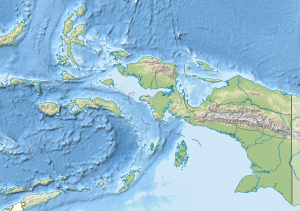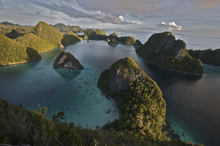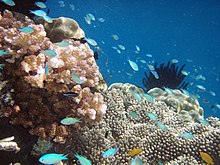Raja Ampat
| Raja Ampat | ||
|---|---|---|
| Waters | Halmaherasee , Seramsee | |
| Geographical location | 0 ° 50 ′ S , 130 ° 30 ′ E | |
|
|
||
| Number of islands | 1800 | |
| Main island | Waigeo | |
| Map of Raja Ampat | ||
Raja Ampat (translated the kingdom of the four Rajas ) is an archipelago in the Indo-Pacific in Indonesia .
geography
location
The archipelago is east of the Moluccan island of Halmahera and northwest of the Vogelkop Peninsula of New Guinea . The northernmost point is the island of Fani (group of Asian islands ), which is located directly south of the neighboring state of Palau . 1800 islands belong to Raja Ampat. The four main islands are Misool in the south, Salawati and Batanta in the east, and Waigeo in the north. The Dampierstrasse runs between Waigeo and Gam and Batanta, Salawati and New Guinea in the south. The Bougainvillestraße separates Waigeo in the east of the smaller islands in the West as Kawe and Waiaginseln ( Kepulauan Wayag ). The Sagawin Street separates Batanta from Salawi. The Halmahera Sea connects to the west, the Seram Sea to the south and the open Pacific Ocean to the north .
The islands are very different from each other. The four main islands are mountainous with sandy and rocky coasts. They are mostly surrounded by smaller islands. The small islands beyond the four big ones consist only of rock and stone and are therefore not suitable for agriculture, so that the inhabitants can only earn their living as fishermen.
climate
The archipelago has a humid, tropical climate. The lowest air temperature is 23.6 ° C, the highest at 30.7 ° C. The average temperature is 27.2 ° C with an average humidity of 87%. Rain falls on 19 to 29 days per month, a total of 4306 mm in one year. The southeast monsoon blows from Australia from May to November. It does not contain a lot of moisture, in contrast to the northwest wind from December to April from Asia , which brings a lot of rain.
Administrative division
Almost the entire archipelago has formed the administrative district ( Kabupaten ) Raja Ampat of the province of West Papua ( Papua Barat ) since May 9, 2003 (law number 26 of May 3, 2002 ). However, the south of the island of Salawati belongs to the Sorong administrative district .
The administrative district has a land area of 46,108 km² and a total coastline of 753 km. If you add the sea area to this, Raja Ampat is 4.6 million hectares in size. The administrative district is divided into 24 districts ( Kecamatan ) and 121 villages (117 Kampung and four Kelurahan ). The main town is Wasai ( Waisai ) on Waigeo, about 58 kilometers from the city of Sorong in New Guinea.
| Districts | |||||||
|
|
District | location | |||||
|---|---|---|---|---|---|---|---|
| Ayau | Ayau Island ( Aju ) | ||||||
| Ayau Islands ( Kepulauan Ayau ) | Neighboring islands of Ayaus | ||||||
| Kofiau | Islands of Kofiau, Raja , Boo Islands and other small islands | ||||||
| Meosmanswar | South and west of the island of Gam , Mansuar and Kri | ||||||
| Misool | West of Misool Island and offshore islands (e.g. Nampale , Fafan , Senyu and Gam ) | ||||||
| Mayalibit Bay ( Teluk Mayalibit ) | Waigeo Island , southern part of Mayalibit Bay | ||||||
| North Batanta ( Batanta Utara ) | North of the island of Batanta | ||||||
| Northern Salawati ( Salawati Utara ) | North of Salawati Island | ||||||
| North Waigeo ( Waigeo Utara ) | In the northeast of the island of Waigeo | ||||||
| Ostmisool ( Misool Timur ) | East of Misool Island and islands to the east such as Daram | ||||||
| East Waigeo ( Waigeo Timur ) | Far east of Waigeo Island | ||||||
| Sembilan Islands ( Kepulauan Sembilan ) | Weeim , Nusela Islands and the other Sembilan Islands | ||||||
| South Batanta ( Batanta Selatan ) | South of Batanta Island | ||||||
| South Misool ( Misool Selatan ) | Narrow strip in the southeast of the island of Misool and southeastern islands, such as Warakaraket , Polee ( Pelee ) | ||||||
| South Waigeo ( Waigeo Selatan ) | Southwest of Waigeo and northeast of Gam | ||||||
| Supnin | North of Waigeo | ||||||
| Tiplol Mayalibit | Waigeo Island , northern part of Mayalibit Bay | ||||||
| Wasai ( Kota Wasai ) | Wasai town in the south of Waigeo Island | ||||||
| Wawarboni ( Wawarbomi ) | |||||||
| Westmisool ( Misool Barat ) | South of Misool Island | ||||||
| Western Salawati ( Salawati Barat ) | West of Salawati Island | ||||||
| West Waigeo Mainland ( Waigeo Barat Daratan ) | West of Waigeo and islands northwest of it, such as Kawe and Waiag Islands | ||||||
| West Waigeo Islands ( Waigeo Barat Kepulauan ) | Gag Island , Faminseln , Batang Pele and other islands southwest of Waigeo | ||||||
| Central Salawati ( Salawati Tengah ) | Middle of Salawati Island | ||||||
Residents
35 of the islands are inhabited. In 2010, the Raja Ampat administrative district had 60,386 inhabitants (33,486 men, 26,918 women). In 2001 there were 47,771. Seven languages are spoken. Almost the entire population lives by the sea, the villages partly consist of stilt houses in the sea. Only in the Kampungs Kalobo , Waijan , Tomolol , Wasai and Magey are settled further in the interior of the island.
fauna and Flora
Plate tectonic faults and continental plate drift and thus the dispersion of several endemic species with subsequent reunification of the animal species as well as different rock formations such as steep walls on the one hand and shallow lagoons on the other, ensured the marine biodiversity. Hard corals and mangrove forests form an ideal hiding place for the marine nursery.
The archipelago is located in the so-called Coral Triangle , a center of marine biodiversity. In 2002 a 23-day expedition by the organization Nature Conservancy and some partners counted 505 coral species and 828 fish species, the occurrence of which in Raja Ampat was previously unknown. The Australian ichthyologist Gerald R. Allen was able to count 283 species of fish in a single dive. A total of 1318 fish species have been identified so far. In addition 699 species of molluscs and 537 different types of coral. One of the newly discovered fish species is the bamboo shark Hemiscyllium henryi , which can run across the ocean floor with its pectoral fins.
The area has the highest number of hard coral species in the world for an area of comparable size. A total of 488 species of hard corals have been identified. Of 35 other species that were found on the expedition, 13 were probably new to science. About 75% of the world's known coral species are here. In addition to stone and octocorals , the sessile animals mainly include sponges and many sea squirts , including the green reef sea squirt and the golden sea squirt . The largest mollusk of the coral reefs is the giant clam Tridacna gigas , which reaches a shell length of 1.1 meters . Among the species of fish include manta rays , wrasses , surgeonfish , holocentrinae , snapper , grunts , hawkfish , reef and tilefish , glass and Beilfische , blennies , tiny gobies , and the dwarf seahorse Hippocampus bargibanti and Hippocampus denise , located between sea fans of the genera Muricella and Hide Annella . The brackish water areas are inhabited by archer fish , among others . The region also has the most important nesting site in the Pacific for the world's largest turtle, the leatherback turtle ( Dermochelys coriacea ).
The entire area is a candidate for UNESCO World Natural Heritage status . Even the ten times larger Australian Great Barrier Reef has significantly fewer species.
The area has not yet been affected by the El Niño climate phenomenon and is therefore viewed as a possible source for the repopulation of highly endangered coral reefs in the rest of Indonesia and the Philippines . However, it is threatened by dynamite and cyanide fisheries and by deforestation of the trees on the islands.
Economy and transportation
In addition to tourism, there is also potential for other sources of income, although most of the residents are currently still living from fishing. Coconut and palm oil plantations are being planned on Faminseln , Kofiau and Salawati . Salawati has coal and oil, Waigeo and Gag have nickel, Batanta and Misool have gold and raw materials for cement.
Sorong, on neighboring New Guinea, can be reached nationwide by plane and ship. From there there is a boat connection to Wasai.
Web links
- Map of the Raja Ampat archipelago with the boundaries of the villages
- Map of the archipelago of Raja Ampat with most of the island names
- Video of the National Geographic Society with English commentary
Individual evidence
- ↑ a b c d e f g h i Raja Ampat administrative district (Indonesian), accessed April 23, 2015.
- ^ Raja Ampat administrative region: Batas Wilayah Kabupaten Raja Ampat (Indonesian), accessed April 23, 2015.
- ^ Raja Ampat administrative district: Peta Raja Ampat (Indonesian), accessed April 23, 2015.
- ↑ Map of the archipelago of Raja Ampat ( memento of the original from May 25, 2015 in the Internet Archive ) Info: The archive link has been inserted automatically and has not yet been checked. Please check the original and archive link according to the instructions and then remove this notice. , accessed April 21, 2015.
- ↑ GEO 2/2008, p. 110, Lars Abromeit: With the guardians of yesterday
- ^ A b Daniel Knop: Raja Ampat, Center for Marine Biodiversity. in Koralle, marine aquaristic specialist magazine, No. 39, June / July 2006, Natur und Tier Verlag Münster, ISSN 1439-779X
- ↑ Hemiscyllium henryi on Fishbase.org (English)
- ↑ a b c The Nature Conservancy ( Memento of the original from January 15, 2011 in the Internet Archive ) Info: The archive link was inserted automatically and has not yet been checked. Please check the original and archive link according to the instructions and then remove this notice.






